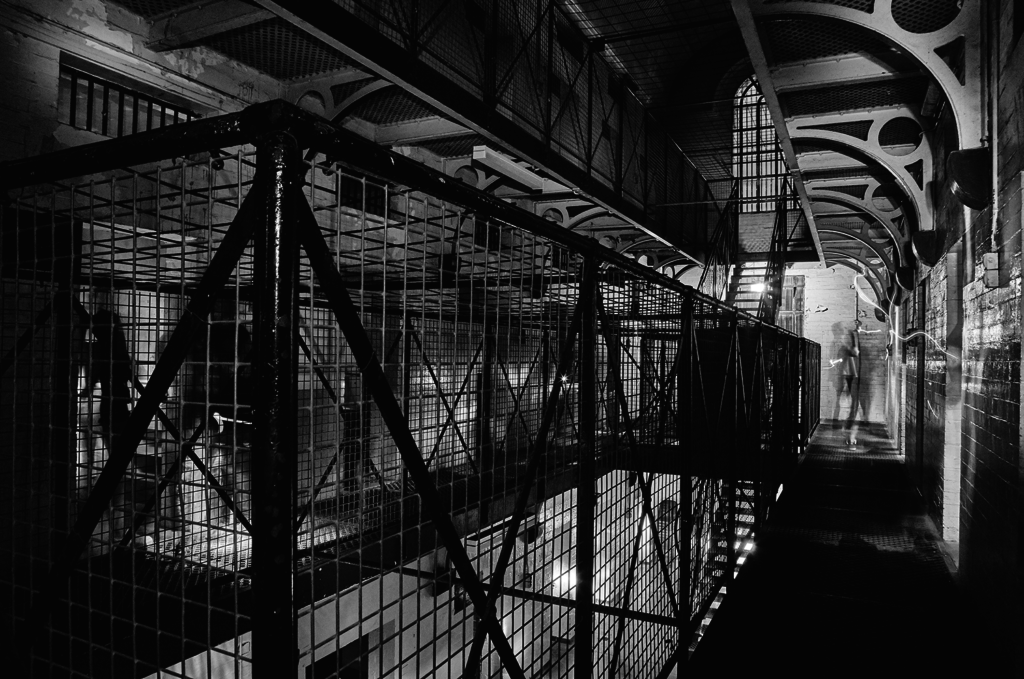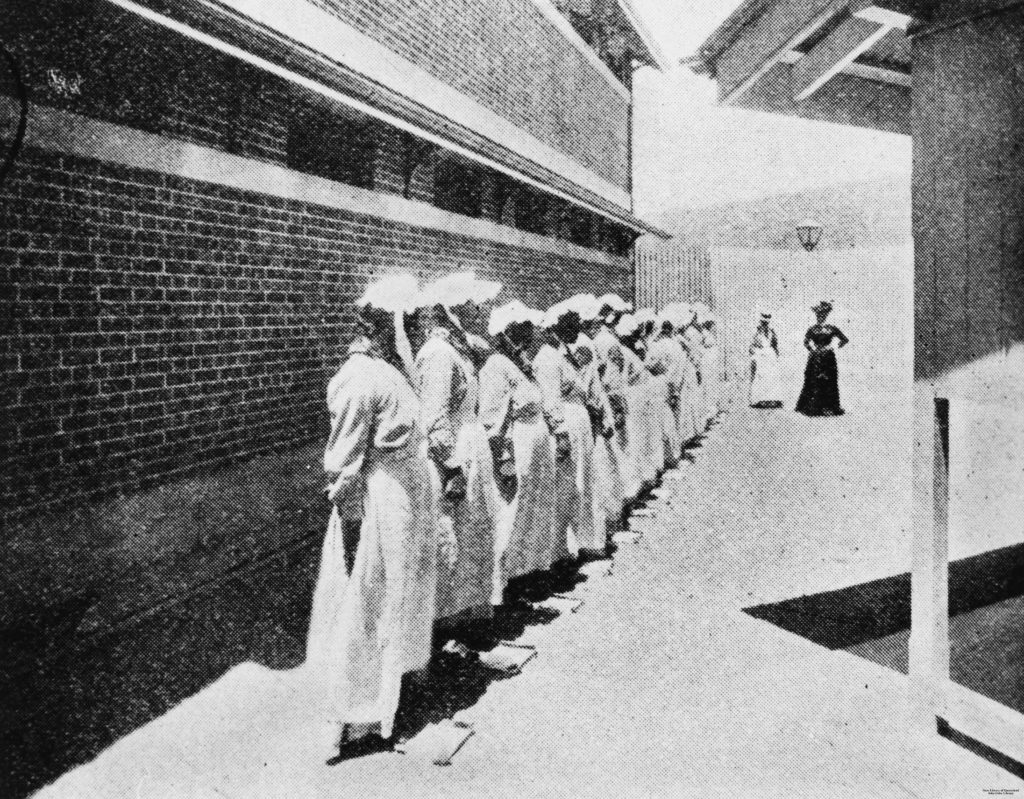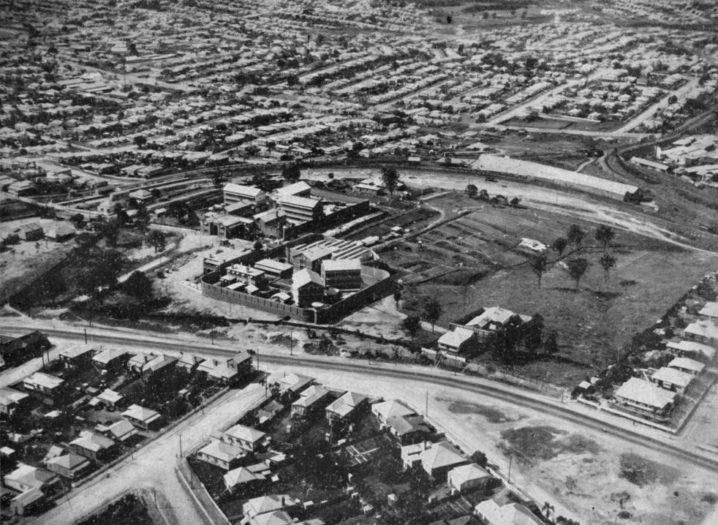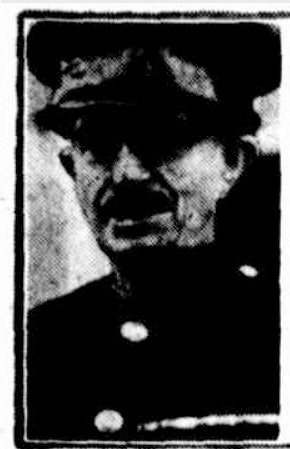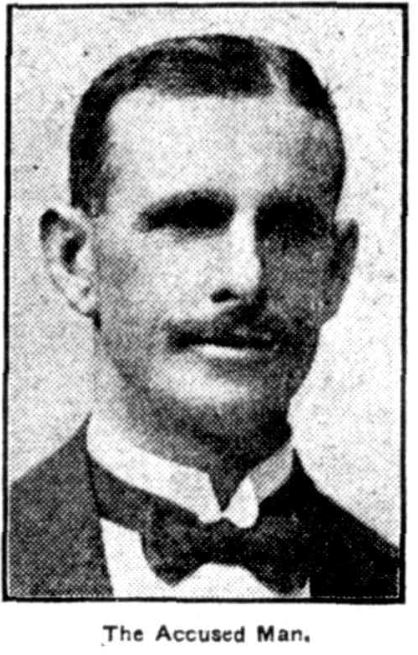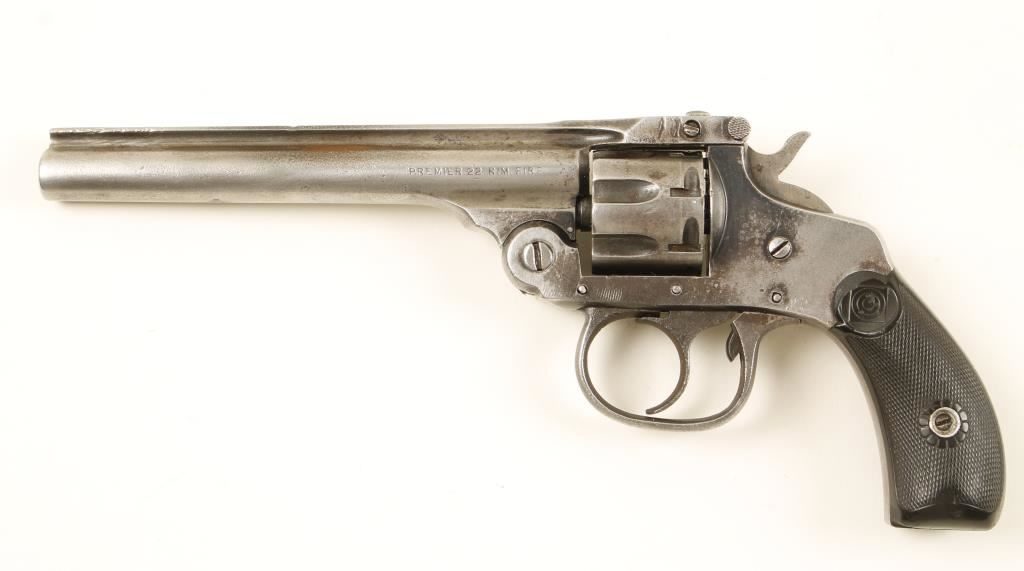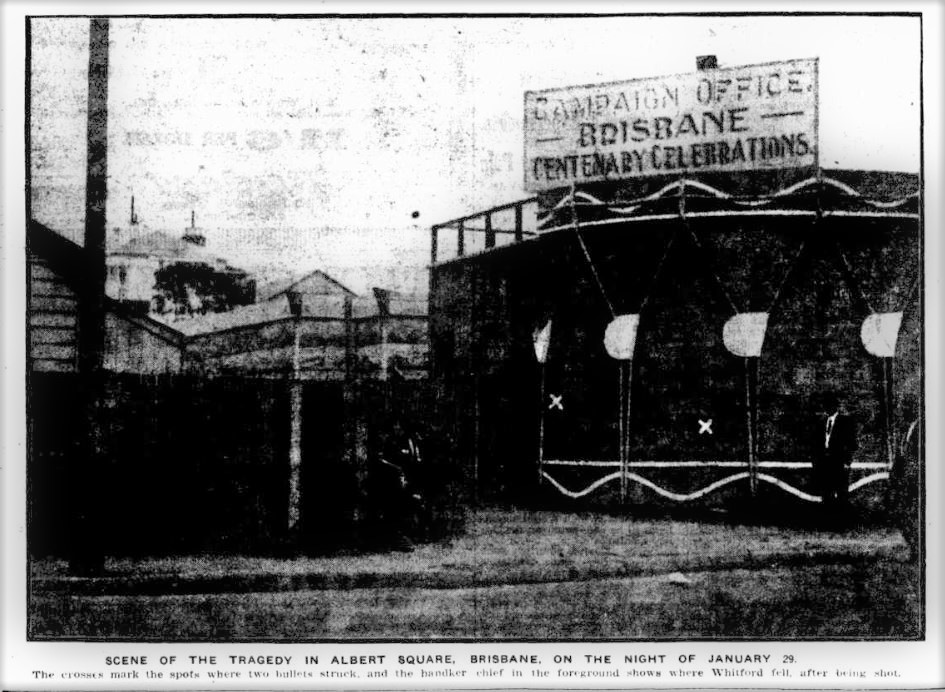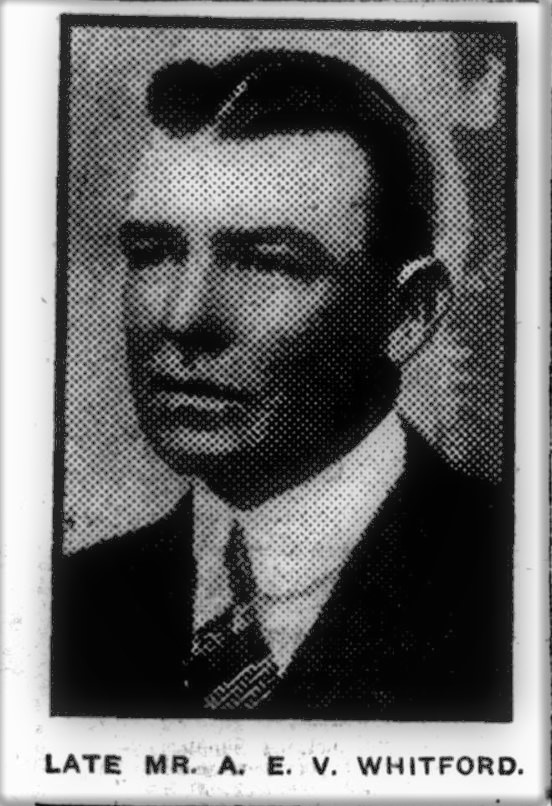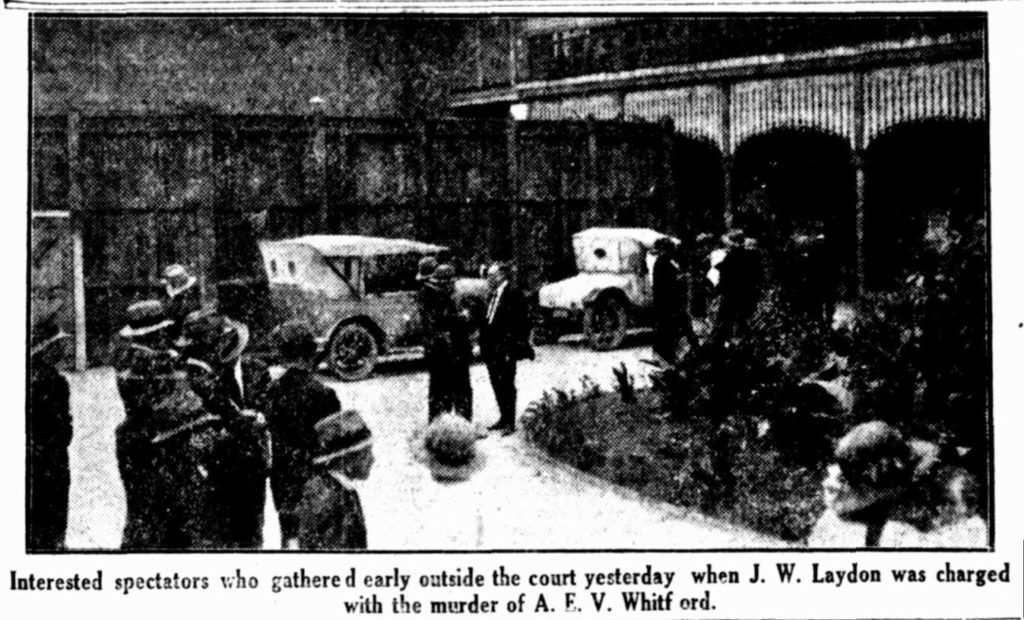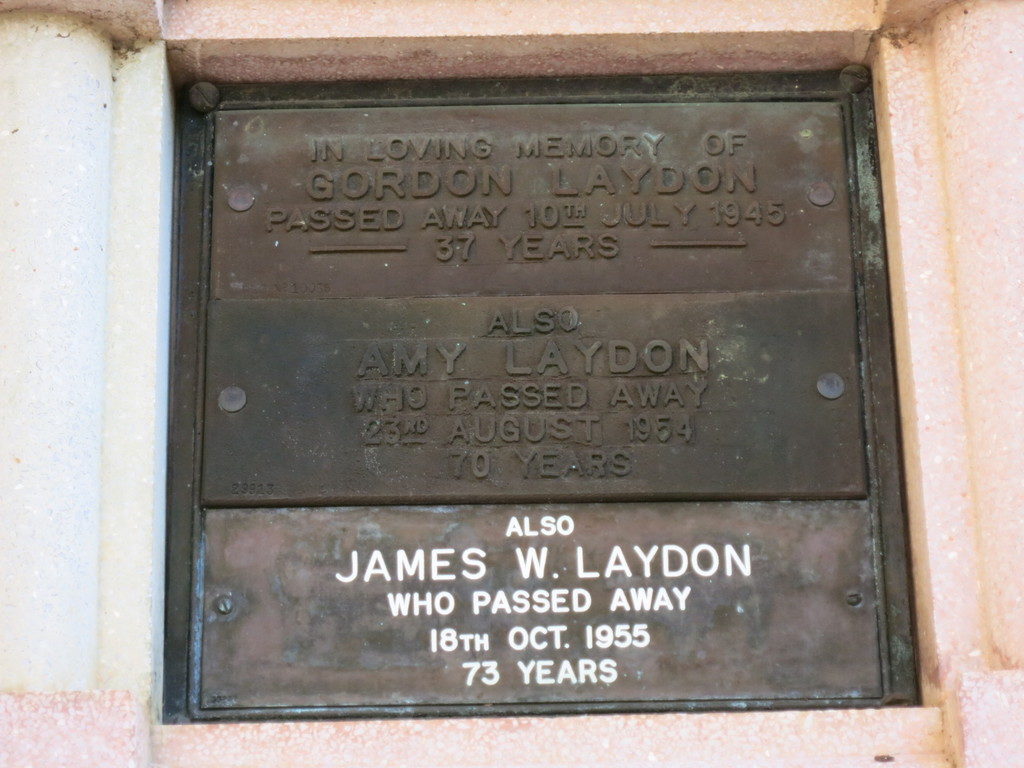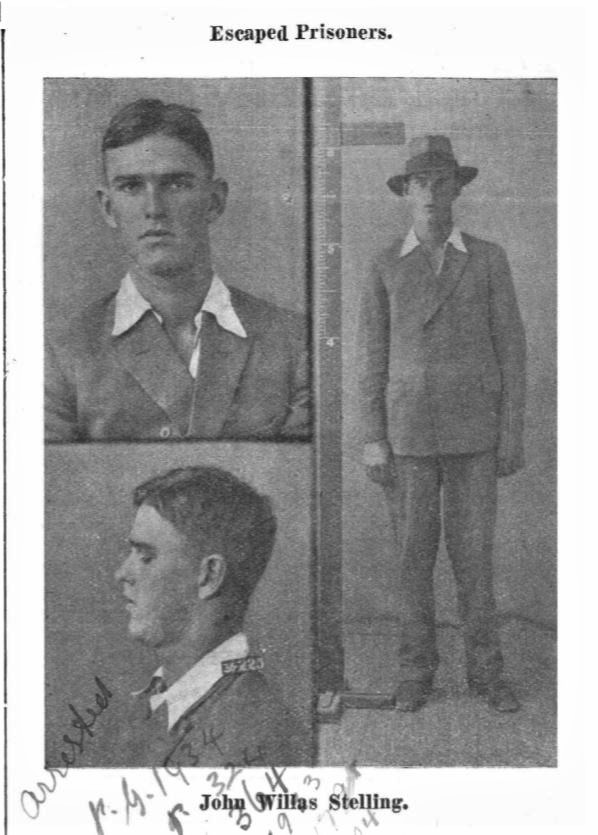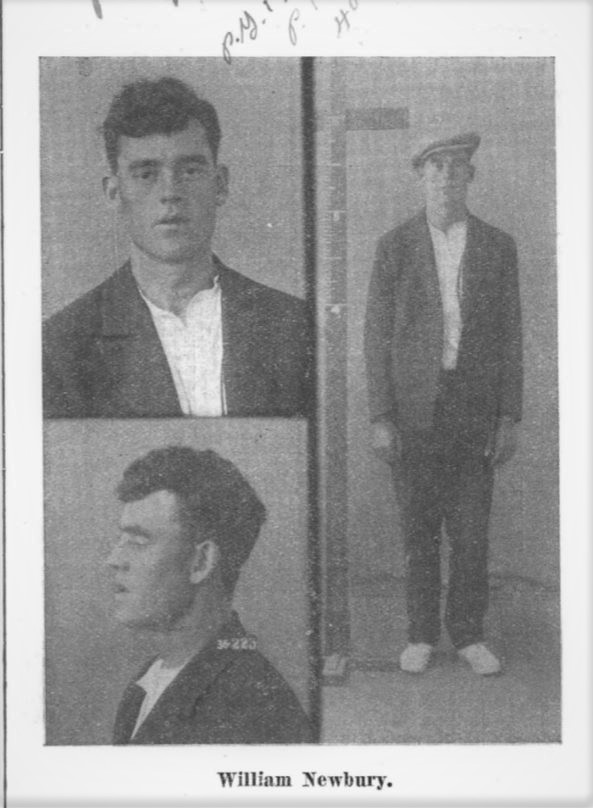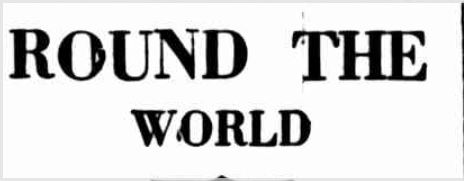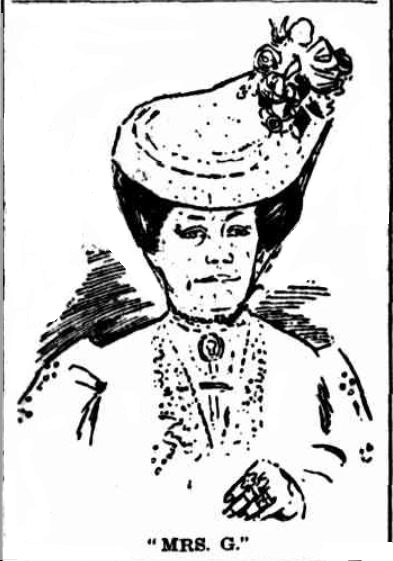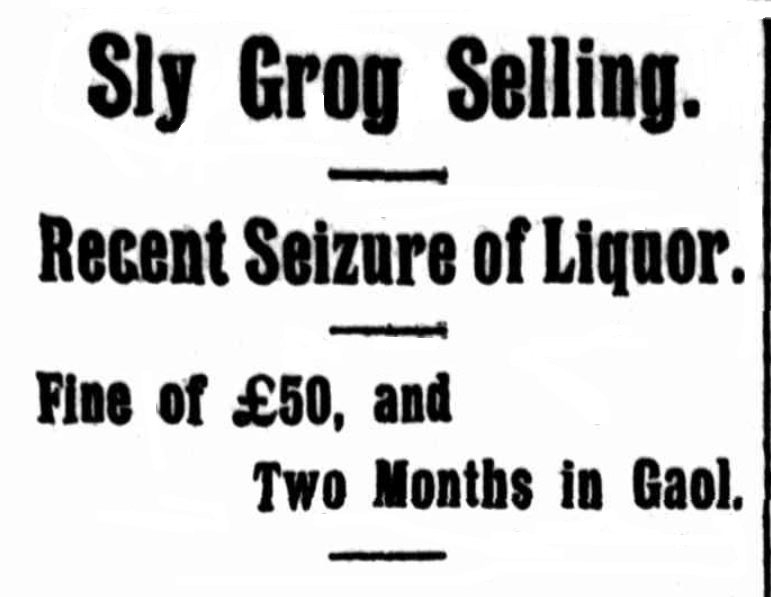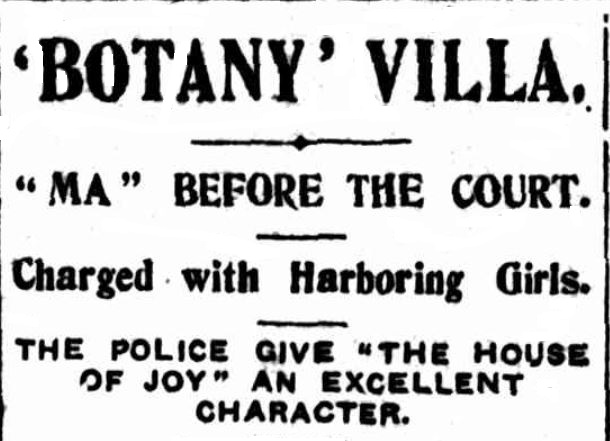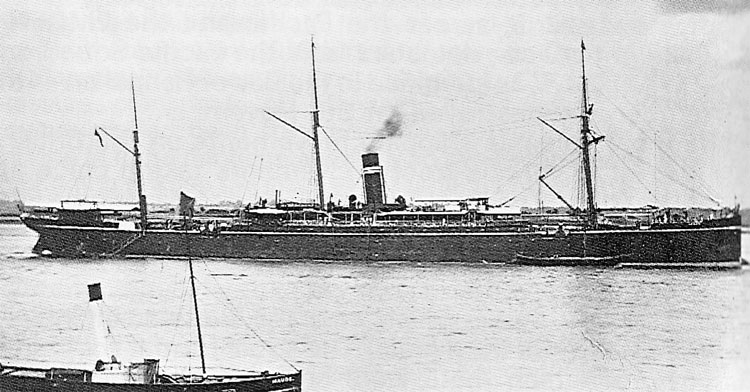“BOGGO” – EPISODE #5 –THE WHISKEY AU GO GO KILLERS
- On : 29 October, 2018
- By : Boggo Road Gaol
- Category : Stories
- View : 3300
“BOGGO” – EPISODE #5 –THE WHISKEY AU GO GO KILLERS – John Andrew Stuart and James Richard Finch – PART 1.
WARNING: Strong content and language.
31st October 2018 – Halloween – marks the 30th Anniversary of James Finch confessing to firebombing the Whiskey Au Go Go nite club at Fortitude Valley.
On Thursday, 8th March, 1973, at 2.08 am, a drum of petrol was rolled into the street-level foyer of the club and set alight with a book of matches. In ten minutes, 15 people – ten men and five women, were dead. It remains Brisbane’s deadliest crime. At the time it was Australia’s worst mass murder, eclipsed only by the tragedy at Port Arthur in 1996.
John Andrew Stuart and James Richard Finch were convicted of the firebombing. Both men were no strangers to prison, having extensive criminal histories for violent crime. However, from the moment of their arrest they protested their innocence, claiming they were setup by corrupt police. After Stuart was found dead in his prison cell on New Years Day 1979, Finch focused on getting out, marrying invalid Cheryl Cole, who tirelessly fought for her husband’s release. Finch was paroled in February 1988. Deported to his native England, having served 15 years for the crime, Finch vowed to return to clear his name.
In a shocking twist, on Monday 31 October 1988 – Halloween – Brisbane’s The Sun front page declared:
Finch confesses I DID IT
Whiskey Au Go Go: The Truth.
The Sun’s London Chief-of-Staff Dennis Watt spent 5 days with the convicted killer. The exclusive interview saw James Finch admit he and John Stuart had lied to their supporters. Finch claimed himself and boxer Tom Hamilton did the deed, while tattooist Billy McKulkin drove the getaway vehicle. Brisbane criminal Vincent O’Dempsey was named as the man who plotted the firebombing. Stuart was paid $5,000 to organise Finch’s involvement.
Listen to Episode #5 of ‘Boggo’ – the official podcast for Boggo Road Gaol.
In this episode, Gaol Director Jack Sim, author of “History of Boggo Road Gaol”, and former prison officer John, talk about Stuart.
Make sure to tune in next week for Part 2.
Visit www.boggoroadgaol.com to book history tours and events.
The Ghosts of Boggo Road Gaol – Boggo Episode 4
- On : 22 October, 2018
- By : Boggo Road Gaol
- Category : Stories
- View : 6606
Ghosts of Boggo Road Gaol -“BOGGO” – Episode #4
Former prison officers and prisoners believed that Boggo Road Gaol was haunted; there are ghost stories dating back to the 1930s. Many people died within the walls of the prison during its long history. Many old officers and prisoners claimed that the prison had a few ghosts. Working in such an ancient place lent itself to stories.
That the Gaol was haunted was something that rarely was mentioned outside its walls when it was in operation, as officers largely kept their experiences to themselves. Usually when they talked about such things their mates would laugh it off or even ridicule them. Prison prankster Ron Darby, a veteran officer, loved nothing more than to play jokes on new officers by running a sheet up a wall on the backtrack as it was called, or, on foggy nights, ride a bike with a sheet over his head along this same section to rattle them.
As well as the jokes, the ghost of “Ernie” – Ernest Austin – the last man hanged at Boggo Road and in the state of Queensland in 1913, was said to torment new prisoners at the Gaol. This story was passed down through the cellblock sweepers and seems to have been told right through the 1980s, making it one Australia’s longest told prison ghost tales.
Brisbane Ghost Tours has conducted historic ghost tours of Boggo Road Gaol since 1998. Over 20 years visitors coming on a tour of No.2 Division – the only remaining section of Brisbane Prison – swear they have had experiences. Some say they have been touched, grabbed or even spoken to by spirits. Many claim to have seen a female figure on the upper floors of the cellblocks – leading to speculation as to who it might be. Ellen Thomson was the only women executed in Queensland; she paid the ultimate penalty on the gallows in the oldest part of Brisbane Prison – old No.1 Division – which was torn down in the 1970s. Another possibility is the ghost is of a former staff member – the Matron of the Women’s Prison (the original use of No.2 Division) or a female warder. Perhaps the most unusual haunting is a three-legged ghost cat – Tripod – who visitors claim has rubbed himself on their legs or been heard meowing.
Listen to Episode #4 of ‘Boggo’ – the official podcast for Boggo Road Gaol.
In this episode, Gaol Director Jack Sim, author of “The Ghosts of Boggo Road Gaol”, and founder of Brisbane Ghost Tours, and Ghost Tour guide Sam, talk about the origins of the ghosts, and explores the history behind them, and whether visitors to the historic gaol today continue to have experiences.
Visit www.brisbaneghosttours.com.au to book the Boggo Road Gaol Ghosts & Gallows Tour.
Visit www.boggoroadgaol.com to book history tours and events.
The Female Division – Boggo Episode 3
- On : 15 October, 2018
- By : Boggo Road Gaol
- Category : Stories
- View : 2523
The Female Division – ‘Boggo’ – Episode 3
Boggo Road Gaol is remembered as a place of punishment for men. It is true…it was. But long before men were locked up in No.2 Division – the section of the prison that remains standing today –- it was a prison for women. For 100 years women were locked up at Boggo Road. Their stories largely untold and often overlooked.
The Female Division
Boggo Road Gaol is remembered as a place of punishment for men. It is true…it was. But long before men were locked up in No.2 Division – the section of the prison that remains standing today –- it was a prison for women. For 100 years women were locked up at Boggo Road. Their stories largely untold and often overlooked.
In 1898-99 the Public Works Department prepared plans for the long-argued for new women’s prison at Boggo Road. The Fortitude Valley Gaol, Toowoomba Gaol and the Roma Gaol, were old and decrepit, their facilities were simply too small or were insecure. Ultimately though, it came down to financial reasons. Repairs and extensions would have cost far more than the construction of an entirely new prison. It simply was financially more viable too, for the prisoners all to be housed in one, new, modern prison.
And so, it was, plans were drafted, and a tender sought. In September 1901 respected Brisbane builders A. Lind and Son secured the tender. It would take some £18,795 (2018 – $3 million) and two years to construct. H.M. Prison for Women was officially handed over by the construction team on the 6th of October 1903. Sixteen ladies and their wardress Sarah Browne moved in that afternoon.
Prisoners from Toowoomba Gaol were brought down to Brisbane by train, arriving at H.M. Prison for Women on the 8th of October 1903. Nineteen ladies were brought down in the charge of David Douglas McKee who will be the Senior Warder, Clerk and Storekeeper for the female division. The possessions of the ladies from Toowoomba Gaol were lost on the Toowoomba Range. They were left with nothing. The final admissions in the first two weeks of the new female prison came directly from the Police Court and the final one on the train from the Roma Gaol on the 15th of October. So, it was, Sarah had 41 prisoners in her charge.
This is just the beginning of the story of the female division at Boggo Road Gaol. Women would feature in the fabric of Boggo Road for over the next 100 years.
Experience the Prison Players on the first Sunday each month – as part of the guided History Tour, which runs 7 days, 11am daily. The actors from the Female Division branch of the Prison Players; Boggo Road Gaol’s very own theatre troupe bring the gaol to life. As visitors you will be taken back to 1907, when the female prison was only a few years old. So, why not escape the 21st century; leave behind the cars, air conditioning, electricity and modern technology. Bring along the family and show them what life was like before all of the modern conveniences and even some of the things we see as basics to everyday. You can pre-book your tickets for the first Sunday of each month here
Listen to Episode #3 of ‘Boggo’ – the official podcast for Boggo Road Gaol. In this podcast, Gaol Research Coordinator Sue and actor Karen – a member of the Female Division, a branch of Boggo Road Gaol’s official live theatre troupe “The Prison Players”, talk about this forgotten history.
Visit www.boggoroadgaol.com to book tours and events.
The Gallows – Boggo Episode 2
- On : 8 October, 2018
- By : Boggo Road Gaol
- Category : Stories
- View : 2450
The Gallows – ‘Boggo’ Episode 2
Between 1883 and 1913, forty-two criminals comprised of thirty-nine men, one woman and two teenagers were executed at Boggo Road Gaol. All were hanged, the last in 1913.
Between 1883 and 1913, forty-two criminals comprised of thirty-nine men, one woman and two teenagers were executed at Boggo Road Gaol. All were hanged, the last in 1913.
The gallows were located in ‘A’ Wing, the original cellblock in the oldest section of the gaol built in 1883 – later known as No. 1 Division. The gallows consisted of three parts:
1 The Beam – a strong timber beam running across the breadth of the cellblock under the upper floor gantry (walkway). Three hooks hung beneath the beam – to which the hangman’s rope could be attached.
2 The Scaffold: the platform that jutted out from the first floor gantry, directly below the beam.
3.The Trap: in the metal floor of the scaffold were two trap doors, located directly below the beam.
At eight o’clock Monday morning, the bell would toll to announce the grim act about to take place. Then the condemned person would be invited by an official to say their last words. The noose was then put around the condemned’s neck. At a signal from an official, the hangman would move a lever which opened the Trap and sent the prisoner to eternity. The body was lowered into a coffin and taken away for burial at South Brisbane Cemetery.
Public agitation for the abolition of capital punishment began in the 1890s. The last man hanged was Ernest Austin on 22 September 1913. In 1922 Queensland became the first state in the British Empire to legislate the end of capital punishment.
Listen to Episode #2 of “Boggo” – the official podcast for Boggo Road Gaol. Join Gaol Director Jack Sim and Research Coordinator Sue as they discuss a new exhibition – “The Gallows” – which explores the history of capital punishment, and punishment, behind the walls of Boggo Road Gaol.
The new exhibition is open everyday at 1pm following the daily History Tour at 11am, and is included in the Boggo Road Gaol Ghosts & Gallows Tour.
Origin of the name – Boggo
- On : 1 October, 2018
- By : Boggo Road Gaol
- Category : Stories
- View : 3787
Origin of the name -Boggo
The distinctive name of Australia’s most notorious prison has a fascinating origin.
The origin of the name “Boggo” may lie with the traditional owners of the area south of the Brisbane River. According to Annie MacKenzie, author of Memories Along the Boggo Track, on the edge of “One Mile Swamp” at Woolloongabba were two leaning trees – referred to as “Bloggo” or “Bolgo”.
From the late 1840s bullock teams headed east along Stanley Street, transporting goods from the wharves at South Brisbane, to Ipswich Town. The rapidly growing commercial centre serving the Darling Downs was considered to be the likely capital of a future new state. The teamsters turned off at these trees, skirting the edge of the swamp, creating a short-cut to Ipswich Road to the west. The route they carved through the dense scrub became a rough, perilous track connecting South Brisbane to the Ipswich Road – called Bolgo Road.
The early track was virtually impassable in wet weather, especially the lowest section from the corner of Stanley Street also called Clarence Corner to the foot of the slope which would become known as the “Gaol hill”. After rain, this section became a “bog-hole”. The aboriginal word “Bloggo” was corrupted to simply “Boggo” and the notorious way to Ipswich Road was locally cursed as the “Boggo-track”. According to local folklore a passenger coach drawn by four horses got bogged so deep that they were never seen again.
The track was surveyed when the Gaol Reserve was mapped in 1863, eventually becoming known as the “Boggo-road”. Over time One Mile Swamp was drained and filled, the Boggo-road raised, widened and graded. In time, the entire area from the former track south-west to the Brisbane River became known as “Boggo”.
The Gaol was never officially “Boggo Road Gaol”. The official name changed over time: H.M. Gaol South Brisbane (1883); H.M. Prison Brisbane (1921); Brisbane Prison Complex (1973-74); finally, Brisbane Correctional Centre (1988).
Locals called it “Boggo-Road Gaol” after the road it was on.
Listen to Episode #1 of “Boggo” the official podcast for Boggo Road Gaol . Join Gaol Director Jack Sim and Research Coordinator Sue as they explain where the word “Boggo” came from and how Boggo Road Gaol was never its official name. Also, don’t forget to come get “locked up” with us on our daily public History Tours running at 11:00am everyday!
This article was contributed by Research Coordinator Sue Olsen as part of the ongoing research program for Boggo Road Gaol Pty Ltd. The aim of the program is to bring to light and share articles relating to Boggo Road for the purposes of review and study. Do you have a story to share or something you would like us to know about? You can contact the research team here.
Officer – Frank “Trooper” Hills
- On : 21 September, 2018
- By : Boggo Road Gaol
- Category : Stories
- View : 1952
Frank “Trooper” Hills
Frank “Trooper” Hills – Boer War and Gallipoli veteran serves 25 years in Boggo Road Gaol. Not how you think, he was an officer and a gentleman.
Frank Hills, known to everyone as “Trooper”, was born in Brighton, England to William Nash Hills and Fanny Morell.
His nickname “Trooper” was gained through his extensive military career in the Australian Light Horse. He served his country with pride, from the Boer War through to the end of the first world war with only a few days between deployments. He was twice wounded at Gallipoli, rapidly rising through the ranks as the 9th Infantry arrived at Gallipoli. On enlistment he was a private, two days later promoted to Corporal, and three days later again to Sergeant. As the history books tell us, Gallipoli was a terrible campaign with a tragic loss of life. The army needed good experienced soldiers to lead their young men into battle, I suppose this is how trooper got promoted so quickly, a little older at almost 32, with his experience it is little surprise the promotions happened as they did. Less than a year later he was promoted to Company Sergeant Major, and eventually temporary Regiment Sergeant Major.
Next the campaign would take “Trooper” to France. Where again he was wounded. Dispatched to England for medical treatment he would return to the front a few weeks later after some rest. Finally transferred home in 1918 as part of a unit to guard submarine bases in Sydney.
Prison Service
“Trooper” joined the prison service as a probationary warder on the 4th of April 1919, just one month after being discharged from the Army. First posted to St Helena, he was involved in several prisoner related problems. One fellow warder being slashed in the throat with a knife.
“Trooper” then later moved to Boggo Road Gaol where he would serve the remainder of his 29 years in the service. “Trooper” kept his head down and was a good prison officer, he had great consideration for his fellow man and when interviewed after his retirement he would talk about the times of prisoners at the gaol and believed that the majority of men under his care were merely victims of circumstance. Of course there were some “Bad Eggs” he said.
Perhaps the most interesting and sensational time of Trooper’s career at Boggo Road was the discovery of the Cyanide Plot of 1940. A prisoner William Edward Langford smuggled a deadly vial of Cyanide under his armpit into Boggo Road Gaol. It only being discovered on a pat down search of the prisoner before putting him in his cell. The prisoner shouted for the warders “For god sake tell that man not to open that vial and smell it – it will knock him _____ out”. It was soon discovered that the vial contained enough Cyanide to kill 50 people. The 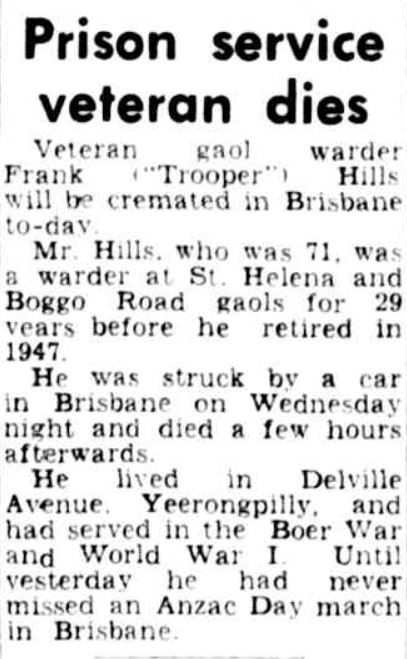
Retirement
“Trooper” would retire in 1947 to his home in Yeerongpilly with his wife, Helen. Throughout all of the years after returning home from the war, he never once missed an Anzac Day service. Tragically, on the 23rd of April 1952, while crossing the street. “Trooper” Hills was struck by a car and died in the Brisbane General Hospital just a few hours later, he was 67. Anzac Day 1952 would be the only one he ever missed. He was cremated at Mt Thompson crematorium on the 26th of April 1952, his ashes laid to rest with his wife who survived him by just six years.
Want to know what it was like to be an officer at Boggo Road Gaol? Come along this Sunday for our officer tour and meet former officer Kevin Hayden! For more information click here
This article was contributed by Research Coordinator Sue Olsen as part of the ongoing research program for Boggo Road Gaol Pty Ltd. The aim of the program is to bring to light and share articles relating to Boggo Road for the purposes of review and study. Do you have a story to share or something you would like us to know about? You can contact the research team here.
LIFER – James William Laydon
- On : 13 September, 2018
- By : Boggo Road Gaol
- Category : Stories
- View : 2337
LIFER – James William Laydon
It was a fine evening, dinner and a show at the glorious Tivoli Theatre. Shortly after 8:30pm shots rang out, Ex- Parliamentarian Whitford was dead and James William Laydon was on the run. Jealousy, the green-eyed monster had struck a fatal blow and it would strike a ruinous path through two families. Laydon – “I was taught at the war to kill my enemies, I killed many there that never did me any harm. Shooting was too good for that mongrel”
Crime: Wilful Murder
Native Place: England
Age: 39 years
Height: 5 feet 3½ inches (161cm)
Build: Slight
Complexion: Fresh
Hair: Grey
Eyes: Blue
Weight: 8 Stone 2 ounces (52kg)
Remarks: Small scar left thumb; left little finger been broken; two vaccination marks left bicep; large scar outside right hand; four white marks left bicep; varicose veins left leg; large operation scar right side of stomach.
James William Laydon
Born in Durham England, the third son of Thomas and Bridget Laydon. He was married to Amy Wilson in Durham and they had their eldest two children in the Sunderland district. the family arrived in Queensland in 1911 as third-class passengers aboard the ship Orveito. The family lived in Princhester street at West End before later moving to 10 Prospect Terrace, Highgate Hill for remainder of their lives.
At the time of his arrest, Laydon was working as a Labourer. He had however been a soldier in the first world war and was a carpenter by trade. His army record is of an excellent character. During his service he served in the battle of the Somme. Wounded and gassed, he certainly had seen and done some horrible things in service for his country. When war broke out he enlisted voluntarily, serving the entire war and returning to Australia in 1919. It was his excellent record that he would later rely upon in his defence.
Understandably, times were tough during the war, his wife with three children, 8,6 and 1 would have had a difficult time of it. Money would have been tight. It was times like this that one would seek the assistance of friends. You see, the Whitford’s and the Laydon’s were friendly. It comes as no surprise that a struggling Mrs Laydon would have sought help from her friend Mr Whitford. It was the alleged help that she received that was the root cause of all of this trouble.
Prelude to death
On a hot summers evening, Tuesday the 29th of January 1924; The residents of Brisbane were enjoying an evening at the theatre, The Tivoli a modern theatre had all of the latest comforts. Just the thing for an escape from the present. Before the film was over however, an assassination of the worst kind occurred just outside.
Prominent citizen, Albert Whitford, a former parliamentarian and his wife were among the throngs of people enjoying an escape from the heat.
Laydon too had accompanied his wife to the Tivoli Theatre that evening, for a time the pair sat together, but, eventually Laydon left the side of his wife leaving the theatre he is said to have encountered Whitford. Some words were exchanged between the two, Whitford, resenting a remark or two made by Laydon is supposed to have struck him in the mouth. There the matter rested… for a moment.
Laydon returned to his wife but they left just a few minutes later. Just across the square, Mr and Mrs Whitford were enjoying the last of their evening before venturing home. Standing on the corner of Adelaide street, near the foundations of the new city hall, they were engaged in conversation. Unbeknownst to them, their evening would abruptly end and their lives as they know it about to change forever.
In front of the Tivoli, the Laydon’s were having a heated argument as attested by numerous witnesses at the trial. The woman, handsome of face and figure was imploring her husband to “Come Away!” she was clearly anxious to leave. His reply was to shove her violently aside and march across the square towards an oblivious Whitford.
Moments later, Mrs Whitford noticing the shops across the street were still opened. She left her husbands side to make a late-night purchase or two.
Just then, shots rang out.
The Crime
Laydon reaching the Adelaide Street corner, stepped in closer. Mr. Whitford looked up, Laydon launched a few more venomous words, Mr Whitford turned to walk away, before he had taken a pace or two. Shots rang out. Whitford reeled, staggered, tottered and crashed to the ground. With a wound to his head and neck, Whitford was already mortally wounded. Just then, Layden stood over his prone body and said “I haven’t slept for a month, but I have given you something that will put you to sleep forever. That will fix you, you ________”. Then fired three more shots into the body of Mr Whitford.
Mrs Whitford, hearing the shots screamed… Murder! Murder! Whitty! Oh, Whitty! As she ran to his side, assistance was being sought from the police and the ambulance brigade.
Laydon catching up with his wife who had fled when the shots rang out. The making for the Adelaide street Tram climbed aboard and went in the direction of the Hotel Daniell in George Street.
Three police constables, who had heard the shots from their break room in the Roma Street Police Station were quick on their tail. Boarding the same tram, they followed until the reached the rear of the Hotel Daniell. Laydon was arrested on the spot for the suspected murder of Mr. Whitford.
Whitford was by this time dead. He had died in the back of the ambulance on the way to the hospital. Life having been declared extinct the surgeon on duty ordered the body of Whitford be taken to the Morgue at once for post mortem.
There were numerous witnesses to the ghastly assassination of a Prominent citizen of Brisbane, and no sooner had the remains of Mr Whitford left the square, there was a queue to give evidence to the police. Indeed, it was soon after that hundreds of theatre goers were inspecting the spot where the poor man collapsed. The newspaper he was carrying covered in his blood was all that remained.
Police after some pushing managed to get information out of Laydon as to the location of the weapon used in the crime. The seven chambered .22 calibre Harrington- Richardson Premier revolver was located just over the wall in new city hall construction site.
Five bullets had been fired into Mr. Whitford the other two, had lodged in a large advertising barrel located adjacent to the crime scene. These were presented as evidence at his trial.
Albert Edward Victor Whitford, the son of a British soldier who served in the Crimean war was born in Woolwich in 1877; came to Sydney with his parents in 1878. Educated in a public school he served an apprenticeship in the tailoring trade. At twenty he joined the Belmore Political Labor League. Sixteen years later he moved to Inverell and joined the local political Labor League. Coming to Queensland in 1910 he began business in Childers soon afterwards became President of the W.P.O and acted as advisor during the big sugar strike.
Whitford stood against Colonel C.W.D Rankin for the seat of Burrum in the 1912 and 1915 elections but was soundly defeated. He eventually captured the seat of Burrum in the 1918 election but only held it for one Parliament.
Coming to Brisbane with his family he went into business. Whitford was one of the original members of the Cooparoo Turf Club and formed the Unregistered Trainers and Owners Association.
Survived by his wife and four children – two sons and two daughters. He was buried at the Toowong Cemetery the day after the shooting with the burial rights from the Church of England.
His wife still resided in the family home in Union Street, Toombul until she passed in 1954. She was buried in the Nudgee Catholic Cemetery.
Trials and Sentence
Laydon appeared before the Police Magistrate Archdall the very next day. This trial spanned over the next four days. Each day the court room and every available vantage point was packed with spectators wishing to see the villain that killed Mr. Whitford. Before the Magistrate, the facts of the case laid out before him, with a brief of evidence from the police constables outlining the circumstances of the arrest. The defence having refused the opportunity to outline its case in the lower court reserved its evidence for the trial. Laydon was committed for trial for Wilful Murder at the Supreme Court, Brisbane on the 18th of March 1924.
Justice O’Sullivan in swearing in the jury on the morning of the 18th of March, advised that it would be a substantial trial running over a number of days. The public this time were excluded from the court. The only members allowed in belonged to the press, the police and the respective legal parties from either side. Still, the courtroom was full to capacity. Hundreds of people gathered outside in the garden, waiting for any opportunity for news of the trial, or to see Laydon close up.
The defence, in its opening statement alleged that the motive for the crime was one of a Jealous rage caused by the fact that there was an affair between Mrs Laydon and Mr Whitford while Laydon was away at war. Without putting too finer point on it, the defence was motioning for an insanity plea. Interestingly however, as the trial went on no medical practitioners were called to enforce this point.
Reference was made to the good character of Laydon, that he was a returned soldier from the Somme battlefield where he was gassed and wounded. He came home to find that his wife had allegedly been working as a prostitute in a house in Merivale Street “Mother Eva’s” and also known at another house “Mother Ryan’s” It is also alleged that she had an affair with Mr. Whitford. Again, no witnesses from either of the brothels were called, and Mr Whitford was no longer able to answer to the allegation of infidelity against him. The only witness, a next-door neighbour made a remarkable deposition. He testified that he had heard the Laydon’s quarrelling and that Mrs Laydon in one particular heated argument had confessed to having an ongoing affair with Whitford. This is too long to publish in its entirety however the full sordid details can be read here
Finally, the most powerful piece of evidence, and the first time such an idea had ever been presented in a court of Queensland. The evidence of medical examiner Dr. Espie Dodds, after providing his evidence the defence questioned whether a man as stout and unhealthy as Mr. Whitford could have died from the shock of the shooting before actually being hit by the bullet. Of course, this too was discounted as being possible.
The evidence was stacked so heavily against him, and yet, Laydon refused to take the stand in his own defence. His solicitor Mr Stanley declared that no man who had plead not guilty to the crime would refuse to speak in his own defence, and that he must be suffering from some type of insanity.
All of these sharp defence moves failed. The jury convicted James William Laydon of the Wilful Murder of Albert Edward Victor Whitford. However, they made motion to the judge for a declaration of mercy in sentencing.
Justice O’Sullivan, however, said that the law was clear, he was unable to reduce the sentence for the verdict of Guilty of Wilful Murder. As the only other punishment for such a crime – the death penalty – had been stood aside some two years previously. He was obliged to pass sentence as is required by law. Fourteen years penal servitude with hard labour at His Majesty’s prison, South Brisbane (later known as Boggo Road Gaol)
Sentence Appeals
Certain sections of the community thought Laydon got just what he deserved. Others thought he had been hardly done by. That in fact he was insane, and that his actions were caused by the wrong doing of Whitford and his Mrs. Laydon in combination with the remnants of his wartime weariness.
As soon as the trial was over, other former members of the services from the first world war began agitating in his favour. You see, there was no such diagnosis for post traumatic stress in these days. Shellshock was a term used but was not so widely recognised as to have graced the courts of law as a viable excuse for murder.
The Returned Sailors and Soldiers Imperial League the predecessor to the modern day Returned Servicemen’s League began a petition for the immediate remission of sentence, its goal was to gain 10,000 signatures. By June, the petition had at least that number, it was presented to the Home Secretary for consideration of the Governor and the executive. News came in November, that the remission had been refused.
In 1927, they petitioned again, this time with even more signatures, on account of the King’s coronation. Usual procedure would be to give all long-term sentence men a slight reduction in sentence on special occasions such as a regal birthday or coronation. Again, it was refused.
Finally, in 1929 with the election of the Moore government, a third petition was created. This time with 16,000 signatures. Again, deputation was made to the Home Secretary, who dutifully submitted it to the Governor and Executive.
This time, after much consideration, remission was granted. James William Laydon had his sentence reduced to seven years. His release date would be 17th of March 1931.
Released
Once the gates of Boggo Road Gaol swung open, Laydon was greeted by his son and hurried away by motor car. The press who had been waiting outside their Princhester Street home were to be kept waiting. Laydon refused to speak to the press. His wife, Amy, spoke briefly stating that she had been waiting for this day for seven years, and now that it is all over I will not let anybody in to see him. He has paid the penalty and that is the end of it. He Is well and hopes to get a job through the R.S. and S.I.L.A.
The Returned Sailors and Soldiers Imperial league had not completed their task. A letter to the Truth newspaper outlined their final request:
When a man is in trouble, that is the time he finds out that he has friends. Laydon has discovered that he has many warm friends and that they are going to stick-to him und help him to build up his life afresh — to give him a chance for the sake of the days when he was one of the A.I.F. If there are any Diggers or Diggers’ friends who would like to give Jimmy Laydon, who was wounded and gassed on the Somme a fresh chance in life. the State secretary of the R.S. and S.I.L.A, Anzac
Club. Elizabeth-street, Brisbane, would like to hear from them.
James and Amy Laydon retired in their home in Prospect terrace at Highgate Hill and died within a year of each other. They were cremated, and their remains are in a niche at Mt Thompson Crematorium.
This Sunday, you can hear more stories from a prisoner’s perspective. Wayne Weaver, a former prisoner at Boggo Road, will guide you through some of the most turbulent years of the Gaol’s history. To book tickets for our fascinating prisoner tour click here.
This article was contributed by Research Coordinator Sue Olsen as part of the ongoing research program for Boggo Road Gaol Pty Ltd. The aim of the program is to bring to light and share articles relating to Boggo Road for the purposes of review and study. Do you have a story to share or something you would like us to know about? You can contact the research team here
The Reverse Escape
- On : 7 September, 2018
- By : Boggo Road Gaol
- Category : Stories
- View : 1883
The Reverse Escape – John Willas Stelling and William Newberry
Three young men; each of them out of work and down on their luck broached the big lights of Brisbane for a change in their fortunes. Three days and a short voyage later their trip to Brisbane would end in salvation for one and for the other two a twelve month stay in a hell hole.
John Stelling (Description at discharge)
Native Place: South Australia
Age: 25
Height: 6 feet (183cm)
Build: Proportionate
Complexion: Fresh
Hair: Fair
Eyes: Blue
Weight: 11 stone 8 oz (73.5kg)
Remarks: Tattoo of woman on back of left forearm, sailing ship and anchor and “Homeward Bound” on front. And “Laurel” on right forearm. Four small moles on back.
William Newberry (Description at discharge)
Age: 23
Height: 5 feet 10 inches (178cm)
Build: Proportionate
Complexion: Fresh
Hair: Dark Brown
Eyes: Light Blue
Weight: 11 stone (70kg)
Remarks: Top of little finger left hand squashed; large scar inside left thigh.
The Crime
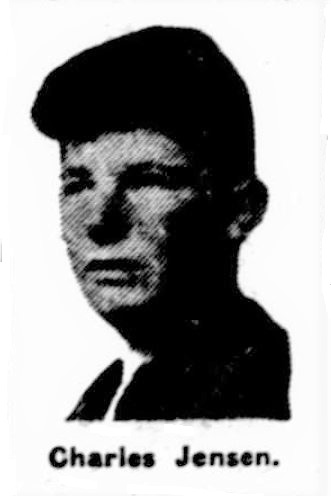
William Newberry, a ships firemen and John Willas Stelling, a seaman, were known to each other. Both having come from South Australia, they had been working on coastal and overseas shipping. Recently having been paid off from their last overseas voyage they had spent their money quenching their thirst from months at sea. All well and good, but now they found themselves broke and in need of work. No problem! They would just get another job and earn themselves more. Of course, there is an economic downfall, and no one is hiring.
Sometime on the road from the Port of Melbourne to Brisbane they came across young Charles Henry Jensen, who had left Melbourne and decided to seek his fortune elsewhere. The eighteen-year-old labourer had even less prospects than Newberry and Stelling, with no family in Australia he really was in a dire situation. Whether they took pity on him or whether he just decided to tag along is not known.
The trio arrived in Brisbane on the 25th of October, trying their luck on the coastal ships at the Hamilton reach they came up empty. It was clear they had to come up with another plan. Meanwhile the crew of a local ship had taken pity on them and plied them with a bit of drink and a friendly game of cards.
In the wee hours of the 26th, still drunk from their outing with the crew. The wily Stelling and Newberry spied the Helene II, the vessel belonging to Colonel Frederick Annand being loaded with provisions for its master and his friends. A little further out the Mako owned by Dr Val McDowell. Spotting the dinghy belonging to George Robinson, the three men pushed it into the water, making for the Helene 2 a motor launch with the plan of transferring its provisions to the Mako, a much larger and sea going motor launch.
Shipwrecked
They broke a skylight gaining access to the Mako but were unable to start her. Transferring back to the Helene II, they then towed her down river. Jensen acting as pilot, the voyage was going swimmingly until in the early morning light, a large ship appeared on their bow. Having no knowledge of the river they sailed the wrong side of the beacons. The wash of the ship running them aground on Wreck Island (later known as Bishop Island and now part of the Port of Brisbane)
Once ashore, the men decided it would be best to eat and gather their strength. There were ample provisions and a bottle of Brandy aboard the Doctor’s launch. They found a hurricane lamp to use as a stove, but it toppled over setting fire to the Helene II. The two experienced seamen quickly quenched the fire but not before terrible damage had been done. They were forced to eat their meal cold and raw. No doubt adding to their misery.
Daylight saw the three men, insect bitten and musing their bad luck. Of course, Colonel Annand, who had planned a voyage that day had noticed his vessel missing. Dr McDowell too, his motor launch. Report was made to the Water Police, where immediate search was launched. Colonel Annand even had hired an aeroplane for a bird’s eye view. It was Colonel Annand that had first spotted the vessels at the mouth of the river.
Capture
The missing vessels were found ran aground on Wreck Island, abandoned. Jensen, Newberry and Stelling having seen the water police coming, scattered amongst the mangroves in a poor attempt to hide. Taken into custody, they were taken to the lockup and set to appear the next day before Police Magistrate Hishon.
Pleading guilty, the three men were convicted of the theft and damage of the three vessels. Jensen having begged that his behaviour was only due to his being drunk and that he would not have ordinarily undertaken such a foolish venture. The magistrate seemingly took pity of Jensen, releasing him to the care of the Salvation Army with a fifteen-pound surety that he would not appear again within twelve months. Ensign Birt of the Salvation Army undertook to locate his parents who were holidaying in Norway.
Newberry and Stelling were not so lucky. Being found guilty on each of the five charges, they were sentenced to two months with hard labour on each charge, to be served cumulatively.
To St Helena
At this time in Brisbane, the majority of male prisoners were not held at Boggo Road Gaol. Only those with long sentences or those under the sentence of death were held there. Female prisoners having their own division (Number two division and the only remaining portion of Boggo Road Gaol). The short-term men were transported to St Helena Island, in Moreton bay for the duration of their sentence. This prison was more like a prison farm, with more freedom and a less rigid system of management than Boggo Road.
Newberry and Stelling were transported by the government vessel Otter to begin their sentence in November 1929.
Escape!
Tired after just a few short months imprisoned at St Helena, a prison that has a reputation for its brutal treatment of prisoners. Newberry and Stelling decided on the 15th of March that it would be their last day on the Island. Somewhere between 6:30 and 8pm they made their escape. Knocking the padlock off the boathouse storing the rowboats belonging to the government, they eased a boat into the water and paddled silently across the bay.
Their absence was noted around 8pm and the alarm was sounded. Police were contacted, and all attempt was made to locate them in the darkness. Ever so silently they paddled to shore, eventually landing at Lota.
The next morning, the missing boat was located at the mouth of Lota Creek. Newberry and Stelling were no where to be found. It wasn’t until later in the morning that a report of a missing car from Cleveland belonging to Dr. Arthur Howard came in that police had even a clue where to start looking.
The Stolen Car
The distinctive single seater Studebaker Commander straight eight with red crosses on the number plates was eventually located in Guy street at Warwick, just a few miles shy of the border. It was soon discovered that the car had run out of fuel, and rather than risk refuelling, the prisoners simply abandoned it. It was discovered by Warwick Police and returned to the owner without damage.
Newberry Captured
William Newberry had been on the run for three and a half months, when with ten other young men were arrested for malicious damage in Clovelly, a suburb of Sydney, New South Wales. The men had done serious damage to a cottage to the value of fifty pounds as part of a communist action. Newberry of course was using an alias. But it was quickly discovered his true identity. He was sentenced to six months imprisonment in Darlinghurst prison for his role in the communist action. He was then remanded back to Brisbane to face punishment for the escape from St Helena.
Returned to Brisbane he faced sentencing before Police Magistrate Leahy, Newberry was sentenced to an additional two months and fourteen days for the escape from St Helena, in addition to serving the remainder of his sentence. All to be served with hard labour. This time, his sentence would be served in the notorious Boggo Road Gaol.
Surrender
Thursday 27th of September was like any other day at Boggo Road. It started and ended with the ringing of the bell to signal to the prisoners where they were meant to be and when. This day however still had a little more in store for the Superintendent Whitney. Shortly before 8pm, Superintendent Whitney was informed that a man wished to see him at the 
“You got away from St Helena four years ago,” said the Superintendent. “This is a strange place for you to visit!” “Yes, I am Stelling,” replied the escapee “I want to get this business over; can you tell me what to do?” Naturally Mr Whitney took the only course available to him and communicated with the police, who shared his surprise at the reappearance of Stelling.
Twice around the world
From the pages of the Courier Mail, 29th of September 1934.
According to Stelling’s story, after rowing ashore at Lota they then separated, and he had not since heard what had become of Newberry. Prison officials were able to inform, him, however, that his companion had been arrested some time ago.
An engineer by trade, Stelling was anxious to obtain a position on an overseas vessel, and, with that end in view, he set out for Sydney. Without money he was faced with the prospect of covering the journey on foot, but he was able to make his task easier by hailing passing vehicles.
Fortune favoured him when he arrived in Sydney, and within a few days he was on the high seas, booked as an engine-room hand in a cargo vessel. In England he was able to obtain only irregular employment, and eventually found himself once more afloat — this time bound for America.
Stelling was reticent as to the time he spent in the different countries and the names of the vessels in which he travelled, but last year he returned to England. Throughout his wanderings, he declared, he was unhappy in the knowledge that he was a fugitive from justice, and his varying fortunes convinced him that he would have been wiser to have served the remaining four months of his sentence.
Though he was able to obtain regular employment, his return to England did nothing to improve his peace of mind, and he determined to come back to Australia, disclose his identity, and serve the remainder of his term. “I am anxious,” he said yesterday, “to get this wretched business over, and start again with a clean slate.”
To accomplish his purpose, he obtained a berth in an Australian-bound steamer and reached Melbourne early this week. He arrived in Brisbane by train on Thursday afternoon, and four hours later was lodged once more in prison. That he had not been driven to his decision by dire necessity was evidenced by the fact that, when he called on Mr. Whitney, Stelling was well dressed and had money in his pockets.
In the Police Court yesterday Stelling was sentenced to serve a month’s imprisonment, in addition to his four months’ unexpired term. Last night he told the prison authorities that he had been treated more leniently than he had expected, and that his mental anguish during the last four years had more than off-set the success of his bid for liberty.
So, there you have it, the reverse escape that found both parties locked up in the notorious HM Prison Brisbane later known as Boggo Road Gaol, twice. By the time Stelling had turned himself in, St Helena prison had been abandoned, not that they would have risked him escaping to sea one more time, certainly not! What happens to these wily characters is not known, one thing is for sure this is the last time they are seen at the gates of Boggo Road Gaol.
This Sunday come behind the giant red brick walls and heavy steel gates and hear about some of the desperate prisoners that tried to escape Boggo Road Gaol and some of the few that succeeded. You can book your tickets here
This article was contributed by Research Coordinator Sue Olsen as part of the ongoing research program for Boggo Road Gaol Pty Ltd. The aim of the program is to bring to light and share articles relating to Boggo Road for the purposes of review and study. Do you have a story to share or something you would like us to know about? You can contact the research team here
The Duchess- Margaret Gregson
- On : 30 August, 2018
- By : Boggo Road Gaol
- Category : Stories
- View : 2053
The Duchess – Margaret Gregson
Perhaps no one person has been responsible for more prisoners of Boggo Road Gaol than The Duchess of Montague Road – Margaret Gregson.
Native Place: Ireland
Age: 50 years
Height: 5 ft 3 inches (152cm)
Build: Stout
Complexion: Sallow
Hair: Dark Brown
Eyes: Hazel
Weight: 13 stone 7 oz (83kg)
Previous Convictions: 9
Remarks: Ears Pierced; Scar first finger left hand and left arm; Burn mark right arm.
Born Margaret Ellena McAuliffe in 1850 in Kanturk, County Cork, Ireland; she emigrated on the ship General Caulfield with her mother and older brothers. Arriving in September 1864 the family taking up land at Mount Walker.
Five short years later aged just seventeen, Margaret met and married William Alexander Fraser Gregson in the Leyburn courthouse. Gregson a bushman was ten years her senior.
They would start a family the following year, settling in booming tin town of Stanthorpe on the Darling Downs, where William Gregson would open a store ‘Gregson and Prebble’. There they would begin to raise their family. Unfortunately, William Gregson was not a successful shopkeeper and would file for insolvency in 1873. There after he would find himself in trouble with the law for embezzlement. Indeed Gregson would do whatever it takes to care for his growing family.
Over the next ten years, the family would expand to twelve. The pressure of this large family and the financial difficulties had taken its toll. Margaret and William would separate but never divorce. He would return to his home state of New South Wales and she would carry on back in the big smoke with the children.
Turn to Prostitution
Margaret had a large family to raise and while her husband still supported them financially she was determined to make her own way. Taking over a boarding house in Margaret Street, Brisbane; she found herself a career and a way to make a fast buck. “Boarding House” is a very loose term; the house quickly became known for its bawdy behaviour, sly grog and ladies of the evening.
For the next ten years, Margaret would manage the ladies of Margaret Street and expanded her empire to the newly available “Killarney” another notorious house on North Quay.
Margaret appeared before the court regularly on charges of breaching the licencing act, selling sly grog and managing a “disorderly house”. Somehow, she managed to stay for the most part free from gaol, only serving a few short hours in the lock up each time before appearing in court. She was imposed some hefty fines, however, in the lucrative “trade” money was never a problem.
Montague Road
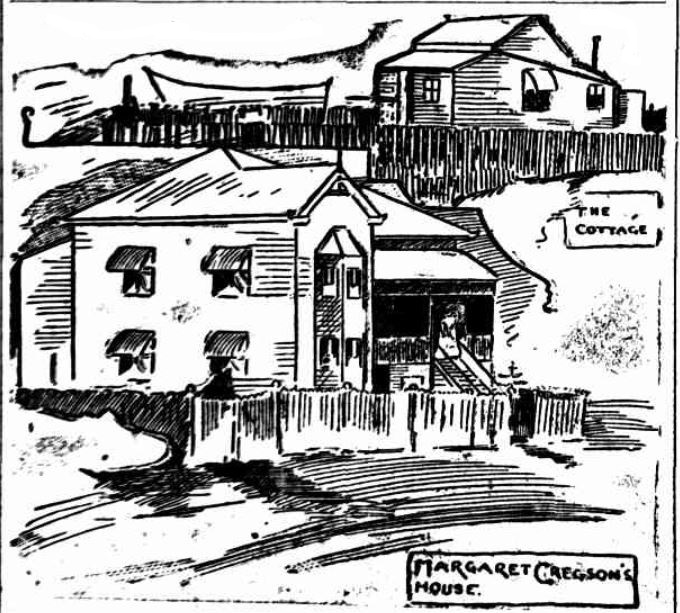
The buildings each having their own name and “functions” or theme. It was a remarkable achievement of its time and was perhaps the largest complex of “disorderly houses” in Queensland.
The houses ‘Botany Villa, SanToy, Bleak House, The Laundry, Marooka, Musgrave Villa and the Wine Shop’ would be the downfall of many a young fallen lady. Equally, it would be the downfall of many a customer; some would leave without their wallets some would barely escape with their lives.
This vast expansion of her empire led Margaret only down one road. Wealth and lots of it. She quickly became known as “The Duchess of Montague Road” but to her girls she was simply known as “Ma or Mother”
Of course, this expansion attracted quite a bit of attention by the licencing men, the police and the courts. Before she knew it The Duchess herself was before the court. Dressed in her finest silk gown, her fur coat, broad hat and wearing all of her jewels. Margaret knew how to make the right impression in public. After all she was an innocent proprietor of a “boarding house”.
The magistrate, who she had appeared before numerous times, had had just about enough of The Duchess and her innate ability to avoid gaol time. Either by legal representation or lack of evidence. This time she was found guilty of selling sly grog at Montague and for harbouring girls for the purposes of a disorderly house. Margaret “The Duchess” Gregson was sentenced to two months imprisonment and a whopping fifty pound fine plus costs. Or in default an additional four months with hard labour.
The Duchess was whisked off in the Black Maria to Her Majesty’s prison for females later known as Boggo Road Gaol. When she arrived, she was admitted just like all the others. However, when she entered the yard, it was like she had walked into her home. You see, the Maison De Joie at Montague was responsible for over thirty-five of the frequent fliers in Boggo Road Gaol at this time, and many, many more in years to come.
Margaret Gregson would only serve her two months imprisonment after paying her fifty-pound fine. This of course would not be the last time the court would see her, nor would it be the last fine that she would pay.
The Duchess – Margaret Gregson would continue working at Montague with a new generation of ‘Lovelies’ and many of the older girls until she retired due to ill health in 1924.
She would linger on for the next two years, eventually passing away in October 1926 at her home at Ascot. Her £25,000 plus estate was left to her seven surviving children and grandchildren. The estate was one of the largest of its time, certainly one of the largest ever seen in her profession. Her remarkable fortune would be worth close to two million dollars in today’s currency.
The only condition placed on the inheritance was that the money was not be spent on anything immoral or illegal. Perhaps, Margaret saw the errors of her ways. Or perhaps she thought herself innocent all along. Either way, the estate would sadly be argued over until the end of 1929.
No other female prisoner in this era had such a profound impact on the story of Boggo Road Gaol. The ladies of Montague would be around the prison for the next twenty years before the houses were demolished to make way for modern commercial buildings.
This story is simply too long, and too wonderful to tell in one go. So, follow along with us over the coming months where we will talk more about the ladies of Montague and the remarkable Margaret Gregson.
This Sunday why not escape the 21st century; leave behind the cars, air conditioning, electricity and modern technology. Bring along the family and show them what life was like before all of the modern conveniences and even some of the things we see as basics to everyday. Click here to secure your tickets.
This article was contributed by Research Coordinator Sue Olsen as part of the ongoing research program for Boggo Road Gaol Pty Ltd. The aim of the program is to bring to light and share articles relating to Boggo Road for the purposes of review and study. Do you have a story to share or something you would like us to know about? You can contact the research team here.
Chief Warder – William Corbett
- On : 24 August, 2018
- By : Boggo Road Gaol
- Category : Stories
- View : 2042
Chief Warder – William Corbett
William Corbett known as Bill, was an experienced warder of thirty-six years in the Queensland Prison Service when he retired aged 67 in 1934. His retirement celebrated on the King’s Birthday was held with great pomp and ceremony. His celebrated career required him to look after some of Queensland’s most notorious prisoners including bushranger and murderer James Kenniff.
Irish by birth, he emigrated from his native County Cavan to Queensland at the age of twenty-one on the immigrant ship Jumna. A sturdy lad he gained employment on the Darling Downs as a labourer and later as a groom and coachman. He met and married Eliza Clarke, his wife in 1897 their son having been born the following year, Bill realised he needed more reliable work. He joined the prison service as a probationary warder on the 22nd of March 1898 and was sent to the Moreton Bay island of St Helena. Bill worked on the island with the long-term male prisoners being sent from Brisbane.
Bill served twelve years on St Helena, with some of the most notorious prisoners in Queensland History, one of them, a name you would be familiar with; James Kenniff, bushranger and brother to Patrick Kenniff. Patrick Kenniff was executed at Boggo Road Gaol (HM Prison Brisbane) in 1903 for the murder of Doyle and Dahlke at Lethbridge’s Pocket. After numerous appeals, James Kenniff’s sentence was commuted to life imprisonment. His sentence was served at St Helena Island initially.
When interviewed by the Sunday Mail in 1940, shortly before his death. Bill Corbett had this to say about James Kenniff: –
‘Jim Kenniff was an exemplary prisoner,’ states Chief Warder W. Corbett, of Highgate Hill, now retired after 36 years’ service. ‘A quiet, unassuming man. He gave us no trouble and was one of the most skilful men with his hands I ever met in prison. He could be taught anything. ‘As were all his family Kenniff was a thorough bushman skilled in all the arts of the bush. For many years he acted as slaughterman and butcher at St. Helena. Afterwards he entered the tailor’s shop and became an expert cutter who could make a suit with any skilled craftsman in Brisbane.’ So highly regarded was he that, by special request of the warders who had been transferred from St. Helena to Brisbane Prison, Kenniff was brought to Boggo Road to become the warders’ cook. It was in this capacity that he served the last portion of his sentence.
Transfer to Brisbane Gaol
After twelve years on the island it was time to move upward again in position for Bill, He had been promoted warder second class and this resulted in his moving back to the big smoke of Brisbane. He entered the service in the men’s division (number 1 gaol) in 1914 and after some time transferred to the new men’s division (number 2 gaol) (the former HM Prison for females) before eventually rising to the rank of chief warder in 1927.
Bill was regarded as a kindly and humane man amongst the prisoners. On his retirement a special ceremony was held in which he was 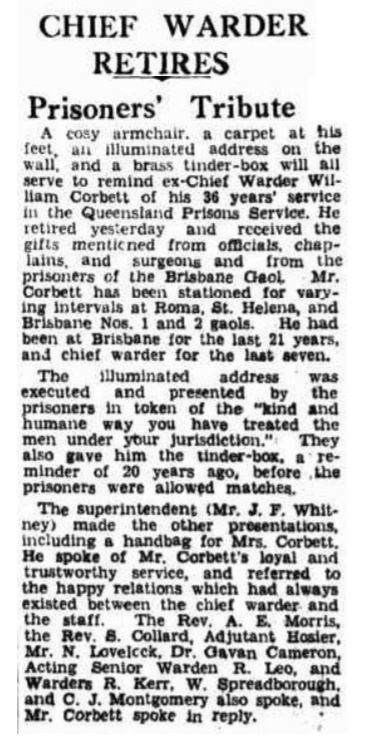
A cosy armchair, a carpet at his feet, an illuminated address on the wall, and a brass tinder box will all serve to remind Ex – Chief Warder William Corbett of his thirty-six years’ service in the Queensland Prisons Service. He retired yesterday and received the gifts mentioned from officials, chaplains and surgeons and from the prisoners of the Brisbane Gaol.
The illuminated address was executed and presented by the prisoners in token of the ‘kind and humane way you have treated the men under your jurisdiction’ they also have him the tinder box a reminder of twenty years ago, before, the prisoners were allowed matches. The superintendent Mr J. F. Whitney made the other presentations including a handbag for Mrs. Corbett.
He spoke of Mr Corbett’s loyal and trustworthy service and referred to the happy relations which had always existed between the chief warder and the staff.
In his retirement speech, Bill Corbett thanked the superintendent and other staff for their kind words. Stating that in his time in the prison service he had witnessed so many changes and good reforms in contrast to the bad living conditions and severe discipline in the gaols years ago. There are now roomy cells, beds, books, electric light and good food of today. In addition, the prisoners nowadays had up to date and hygienic shops, in which to work and they were given greater facilities in regard to correspondence and visits from family and friends.
Retirement
William ‘Bill’ Corbett retired to his Highgate Hill home with his wife, he remained involved in the public service for years, frequently being interviewed for his opinion on various initiatives being peddled by the powers that be. One such instance, he was interviewed in relation to the safety of children at St Helena Island. After the decommission of St Helena as a prison, its likelihood for reuse was debated for many years. In 1937, it was to be converted into a holiday reserve with a causeway to be built from the mainland, and a harbour for yachts erected. As such it would need to be safe for families to visit. There was some debate that it was unhealthy there and that many children had died. William Corbett (who had raised his own children there) greatly disputed this.
William Bill Corbett died just six short years after his retirement aged seventy- three. He was survived by his wife Eliza (nee Clarke) and three grown up children. The esteem in which he was held in the prison service was again put on display at his funeral. The prisoners of Boggo Road sending a cross made from flowers from the prison garden.
This remarkable officer is just one of many that entered the big green iron gates each day. This Sunday, you too can get locked up by one of our former officers! Come inside and find out some of the fascinating aspects of life behind bars. If you are on good behaviour you might even get early parole! You can book your tickets here
This article was contributed by Research Coordinator Sue Olsen as part of the ongoing research program for Boggo Road Gaol Pty Ltd. The aim of the program is to bring to light and share articles relating to Boggo Road for the purposes of review and study. Do you have a story to share or something you would like us to know about? You can contact the research team here


